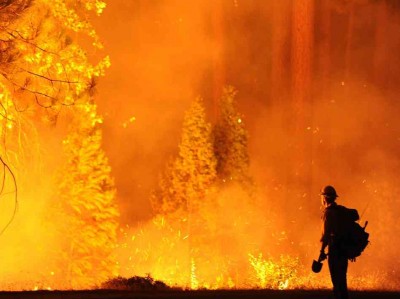
image credit npr.org
The California wildfire that has burned 134,000 acres also has threatened San Francisco’s power and water supply, demonstrating once again the vulnerability of the nation’s power grid.
The wildfire is about 150 miles to the east of San Francisco – a distance seemingly safe for the city, but not when considering the fact that San Francisco gets a portion of its electricity from two hydroelectric generating stations located within the vicinity of the fire and 85 percent of its water from the Hetch Hetchy Reservoir within Yosemite National Park. All are threatened by the fire.
The fire damaged some of the city electrical infrastructure and threatened more significant parts of the San Francisco grid. California Gov. Jerry Brown issued a state of emergency for San Francisco, saying the fire was threatening the equipment and resources of the San Francisco Public Utilities Commission.
San Francisco was forced to shut down transmission lines and purchase replacement energy to fill the void of any lost power.
Brown said the fire threatened to temporarily interrupt electricity and water supply for the city.
Harness the power of the sun when the power goes out…
Although San Francisco does not get all of its power from the vicinity of the fire, what is powered by the two hydroelectric generation stations is significant. Among them: city government offices, the Muni light rail and cable car system, San Francisco General Hospital and San Francisco International Airport.
The fire has been burning since Aug. 17 and on Sunday moved within two miles of the Hetch Hetchy Reservoir.
Firefighter officials posted an update Sunday saying the so-called Rim Fire has consumed 1,500 acres within Yosemite and also burned portions of Stanislaus National Forest. It is only 7 percent contained. The cause of the fire is not known, and officials said the fire likely will continue to grow.
“The Rim incident is expected to continue to exhibit very large fire growth due to extremely dry fuels and inaccessible terrain,” official said in a statement. “Rapid fire growth and extreme fire behavior [are] hampering suppression efforts. … The forecasted high winds and high potential for long range spotting however remains a significant concern for fire to advance beyond the retardant lines and allow for fire spread into the communities of Tuolumne City, Twain Harte and Long Barn to the west of the fire and east into the Hetch Hetchy watershed.”
Nearly 3,000 firefighters have been battling the blaze.
“This fire has continued to pose every challenge that there can be on a fire,” Daniel Berlant, a spokesman with the California Department of Forestry and Fire Protection, told the Associated Press.
The wind isn’t helping. It was listed as 20 mph Sunday evening but was gusting up to 50 mph in some places.
“Winds are increasing, so it’s going to be very challenging,” said Bjorn Frederickson, a spokesman for the U.S. Forest Service.
The Rim Fire also is threatening one of Yosemite’s treasures – its giant sequoias. Although the park remains open, the wildfire has threatened the Merced and Tuolumne Groves of giant sequoias. A statement on Yosemite’s website says the threes are “not currently in imminent danger,” although that could change. By volume, sequoias are the largest trees on earth.
“All of the plants and trees in Yosemite are important, but the giant sequoias are incredibly important both for what they are and as symbols of the National Park System,” park spokesman Scott Gediman told AP.
Some Yosemite campgrounds are being evacuated.
Meanwhile, towns which often serve as hosts for Yostemite visitors are being threatened, too. Among them is Groveland, where Jessica Sanderson and her family owned a cabin that is now destroyed.
“It’s just mind-blowing the way the fire swept through and destroyed it so quickly,” Sanderson said. “The only thing left standing is our barbecue pit.”
Editor’s Note: Containment numbers fluctuate rapidly; containment may have changed between time of writing and publishing.
 Off The Grid News Better Ideas For Off The Grid Living
Off The Grid News Better Ideas For Off The Grid Living




